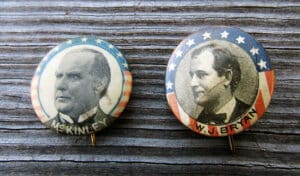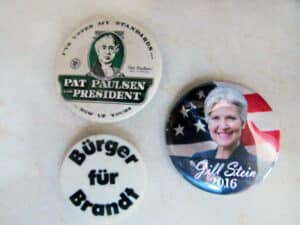By George Sommers
Internet and TV advertising may rule recent political campaigns but campaign buttons, or pinbacks, are still “a thing.” Campaign memorabilia has a long and colorful history – and what better time to start a collection than by going back to the future for items from the 2020 presidential race?
Although campaign paraphernalia previously existed in the form of ribbons, medallions, and painted clothes buttons, campaign buttons as we know them first appeared in the 1896 contest between William McKinley and William Jennings Bryan. That was the year the process of fixing a clear piece of celluloid over a photo was invented. This type of button was largely used from 1896-1917; known as the “Golden Age of Campaign Buttons.” After that, lithographed buttons were introduced. These were cheaper to manufacture using a process of painting over metal.
There have been twists and turns recently in election collecting. Barack Obama’s historical nomination as the first black major-party candidate brought out pride in minority communities and led to the sale of Obama buttons in such unorthodox venues as convenience stores. In 2020, the landscape is now dotted with pop up Trump stores hawking Donald Trump swag. With the COVID-19 pandemic and social distancing, and lacking the pop-up stores, 2020 Biden buttons have been a bit trickier to find. Pre-pandemic, there were some official Biden buttons available at his Manchester, NH headquarters before the New Hampshire primary.
Most collectors are political geeks and part of the fun is collecting buttons at candidate headquarters, conventions, and other assorted candidate appearances and events. Boston collectors got a double bonus in 2004 with the Democratic National Convention being held in Boston and Massachusetts Senator John Kerry as the nominee.

Down-ballot candidates (senator, governor, etc.) are also not usually as prized. However, as generalist collections become big and unwieldy (this writer owns several hundred buttons) some hobbyists branch out to specialize in one candidate’s career – i.e. Richard Nixon’s assorted candidacies for congress, the senate, the governorship of California, the vice presidency, his three runs for president, and finally, his near impeachment.
Also not as prized are items from nomination runners-up: think Bernie Sanders or William Weld in 2020, though again it depends on your tastes. It’s easier to collect these in New Hampshire and Iowa as these states are the first to vote in the nominating process and there are still a wide variety of candidates in the hunt.
Third-party buttons – Socialist Workers, Libertarians, etc., or novelty buttons, like comedian Pat Paulsen’s run or joke buttons for the likes of Morris the cat or the Three Stooges make for a fun sideshow to a collection.
So-called vendor buttons—issued and sold by businesses independent of official campaigns—were at one time snubbed by most collectors. In recent elections, most candidates have gotten a piece of the online action with virtual stores where buttons and other merchandise are sold, i.e. Biden.com. With these online candidate stores, the line between “official” and “vendor” has become blurred. Often, these items are the only game in town so they’ve become part of the mix.
Still universally despised are reproduction buttons, or copies of authentic items often manufactured many years after the actual campaign year and sold as sets. Not surprisingly, some of the most avid collectors are politicians – including former President Bill Clinton. In a rare instance of bipartisan agreement, Congressional Republicans and Democrats decided something had to be done about “repros” so in 1973 the Hobby Reproduction Act was passed. The law “requires that an imitation political item ‘shall be plainly and permanently marked with the calendar year in which such item was manufactured,’” as one American Political Items Collector member explains. Such pinbacks are usually marked “reproduction” on the side or back.

Other types of campaign memorabilia include White House Easter eggs, plastic smiling peanut banks for Jimmy Carter and Donald Trump styled troll dolls. A lock of Abraham Lincoln’s hair sold at auction this past September for $81,250!
So what makes a button valuable? It’s pretty subjective – ask ten experts how much a particular button is worth and you may get ten different answers. The key is rarity. Buttons depicting both the presidential and vice-presidential nominee—known in collector parlance as “jugates”—are collector favorites.
Generally, older buttons are more expensive. Limited edition buttons are the most coveted. Often these tie the candidate with a local politician, place, or event, for instance, a “Smithies for Carter” button tying Carter to the students of Smith College. Speaking of Carter, highly unpopular candidates, as Carter was in his bid for is 1980 re-election bid, may not have had a lot of buttons made. In fact, buttons for the colossally unpopular James Cox/Roosevelt team of 1920 are considered the Holy Grail for collectors. Only 60 are known to be in existence and some have sold for as much as $40,000. The exception to the rule may be Donald Trump. Although as of this writing, he is the underdog in the election and widely unpopular, the base he does have is fiercely loyal and there are many re-elect buttons for him available. Bloopers are desirable as well – like the shortlived McGovern/Eagleton ticket which dissolved when it was disclosed Eagleton had some mental health issues.
Places to obtain current buttons were mentioned earlier, but how does one acquire the older items, say a Wendell Willkie or Franklin Roosevelt? Antique stores are one potential source although availability and variety are hit or miss. You may be lucky enough to come across a hobby shop that specializes in campaign buttons. One such store exists in the Downtown Crossing area of Boston. Your best bet is to attend a local American Political Items Collectors show. There you will see a seemingly endless supply of various types of buttons on sale by club members. The New England Chapter of APIC sponsors shows four times a year at Endicott College in Haverhill, MA.
Your search may be enhanced by a close encounter with a candidate and perhaps even an autograph. This writer owns a “Re-Elect Clinton/Gore” brochure autographed by both candidates.





Related posts: